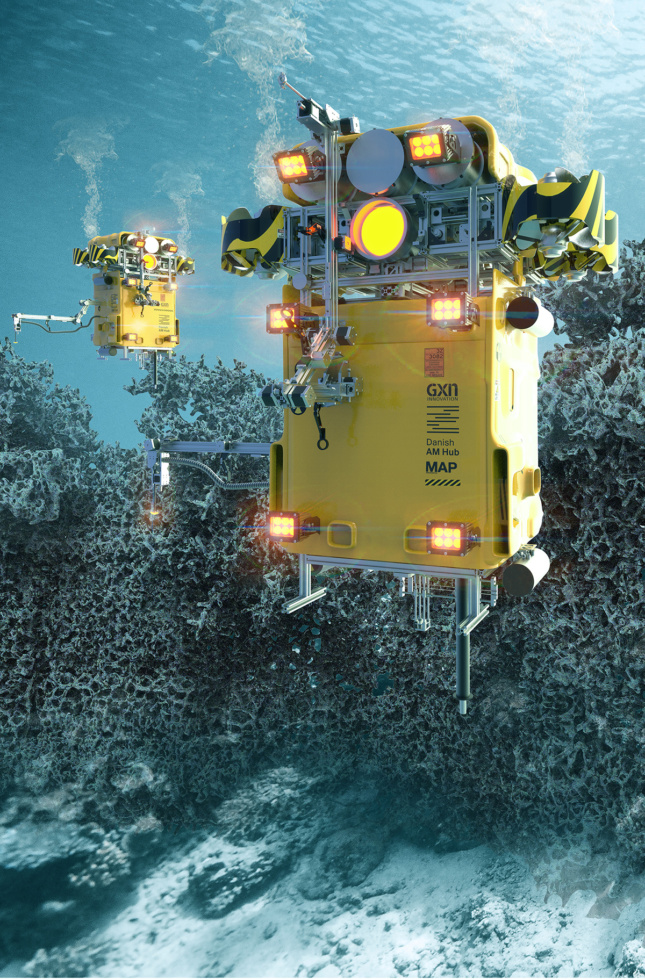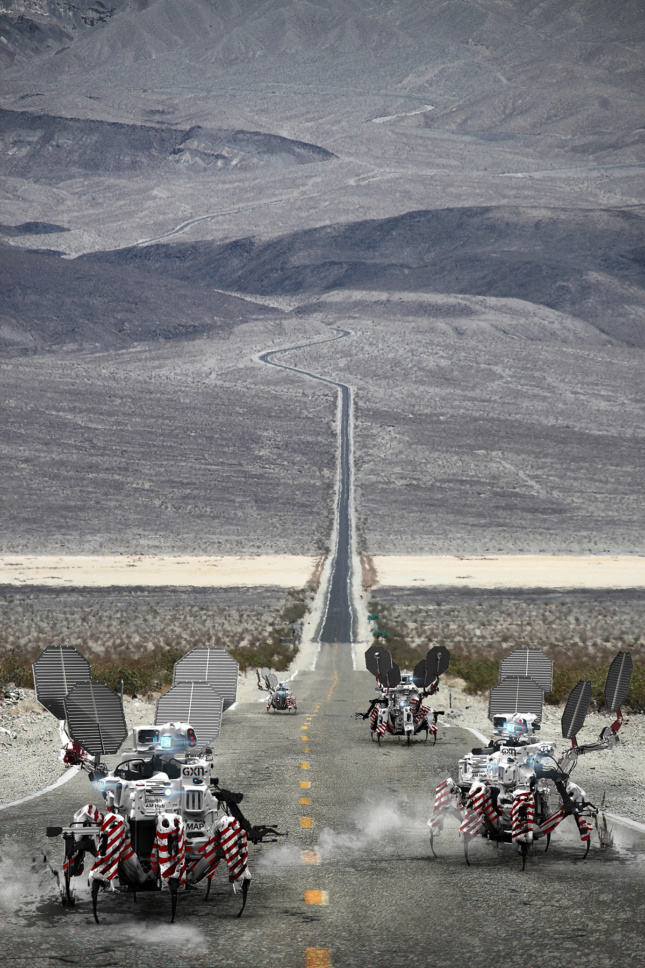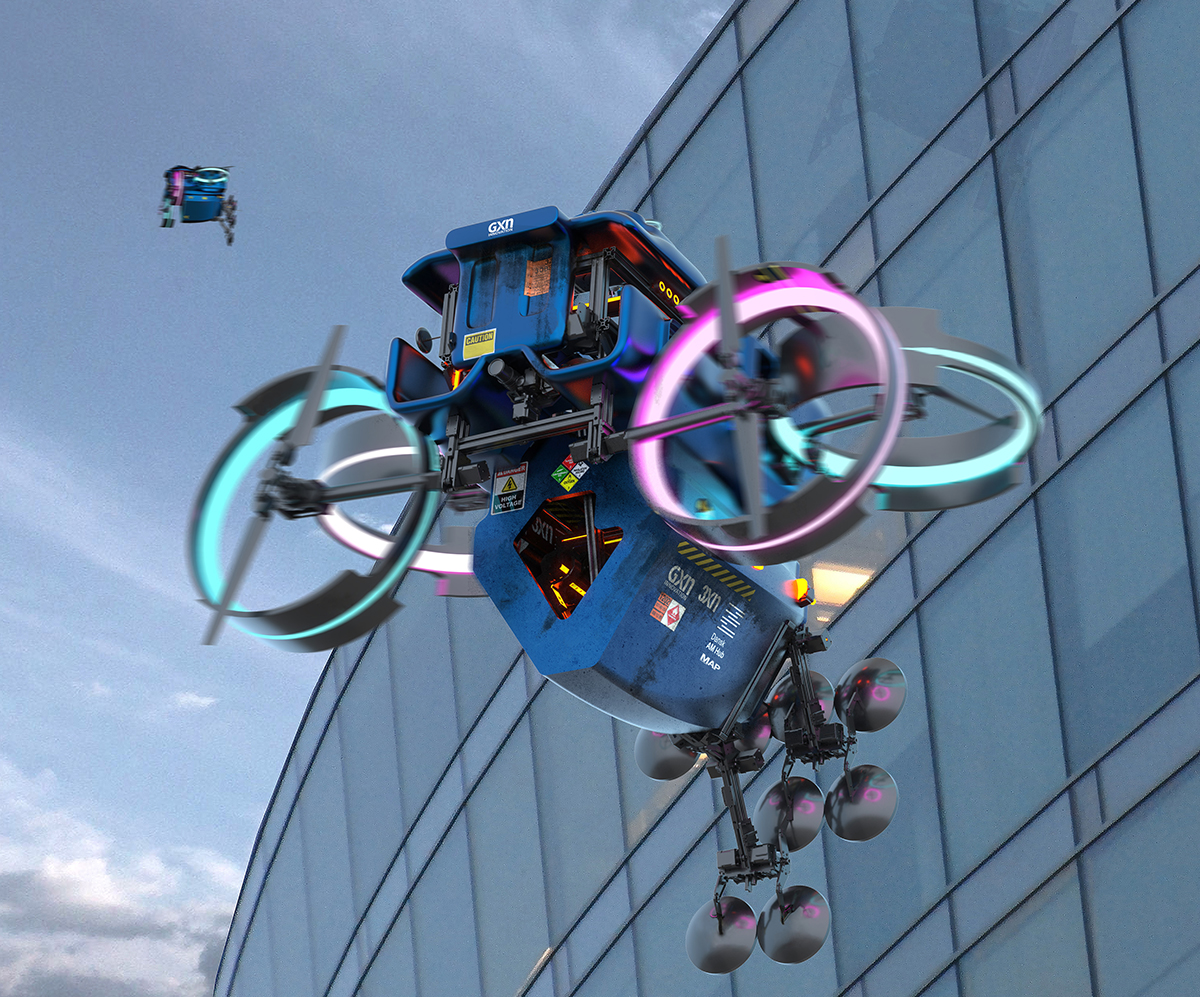Most 3D printers, no matter their size, operate in a pretty similar way: they move along a grid to deposit material, sliding on axes in a fixed manner within a frame. Even those with more flexible arms remain fixed at a point. GXN, the research-focused spinoff of the Danish architecture firm 3XN, is looking to change that, using high-tech robotics to “break the grid” and offer new possibilities in additive manufacturing.
Along with the Dansk AM Hub, a foundation that supports experimentation in additive manufacturing, and MAP architects, GXN has been hacking printers—both mechanically and virtually—to create prototypes that can move through space on land, in the air, and underwater. Their speculative Break the Grid proposal imagines a near future where our buildings and infrastructure can be created and maintained with the help of autonomous, robotic 3D printers that move beyond the normal confines of additive manufacturing devices.

The team started by asking themselves, “Where could we take this if we let our imagination run a little bit free, and what sort of impact would we imagine additive manufacturing having in a positive way in the built environment?” said Kåre Stokholm Poulsgaard, Head of Innovation at GXN. “The goal was to learn something about this,” said Stokholm Poulsgaard, “so we had this idea that we wanted to be able to set the printers free, so we needed to understand robotics and mobility, and what this means.”
GXN took a hacker’s approach to the project. They used existing products, like simple stepper motors and 3D printers already available on the market, to create both mechanical and virtual prototypes. “We wanted to create something new, something that we haven’t seen before, but we also wanted to make sure that whatever we created was tied into existing technologies and capabilities,” explained Stokholm Poulsgaard.
Along with roboticist Teodor Petrov, the GXN team began creating a series of robots, using both cheaply available parts and bespoke components. They also created a variety of digital models and plans, virtual hacks, that in their final form look like something out of a sci-fi video game.

The team behind Break the Grid has selected three main areas where they see autonomous 3D printers as prime opportunities.
The first of these is in addressing global problems in maintaining infrastructure across the globe. It’s estimated that in the U.S. alone, unaddressed issues with highways, bridges, and the like could result in $4 trillion in losses to the economy by 2025. GXN imagines walking robots that could repair microcracks in concrete infrastructure before they eventually become far larger by allowing in water and oxygen, causing corrosion. Inspired by studies done at Rutgers and Bingham Universities, the team imagined a 3D printing robot that deposits the fungus Trichoderma reesei, which encourages calcium carbonate to form, filling in this microcracks and staving off further damage, especially in smaller and more isolated parts of the road.
[interstitial]
GXN also proposes using 3D printing robots on the seafloor to help minimize the damage from coastal storms by 3D printing artificial reefs made from a bio-based cement derived from oysters as a binder. For addressing climate issues on land—or above it, as it were—they imagined drone-printers that can help repair, enhance, and build sections of high-rise facades in order to support their thermal bridges, which are, the team claims, responsible for as much as 30 percent of a building’s heat loss.
GXN hopes that robotic additive manufacturing devices like these could someday work alongside humans to change how construction happens. “Construction is a very large sector in society,” said Stokholm Poulsgaard, “and it’s one of the last large sectors to see comprehensive automation. While all these other sectors are seeing very large productivity growth, the built environment is absolutely flat-lining.” Still, it’s important not to forget that there are many workers in construction. Stokholm Poulsgaard says it’s not about replacing human workers, but about understanding how technology can work alongside people. “Let’s say we have these robots on a building site,” he said, “how do they interface with traditional construction techniques and the people working there in ways that add value and are meaningful? Because robots can do some things better than humans, that goes for artificial intelligence as well, but there’s a lot of stuff it cannot do. How do we let the robots do what they do best to free up people to do what they do best?”
The other hope, besides increases in productivity, safety, and efficiency is added design freedom for architects. “Additive manufacturing promises variation at less or no extra cost,” said Stokholm Poulsgaard, “because they allow you to link up with parametric programs and then mass produce variations of the same components, for example, at a very low cost compared to if you had to do them by hand or traditional means.”
At the moment mobile 3D printing remains purely speculative, but GXN hopes that drones and ROVs will become normal occurrences on construction sites in the near future.
